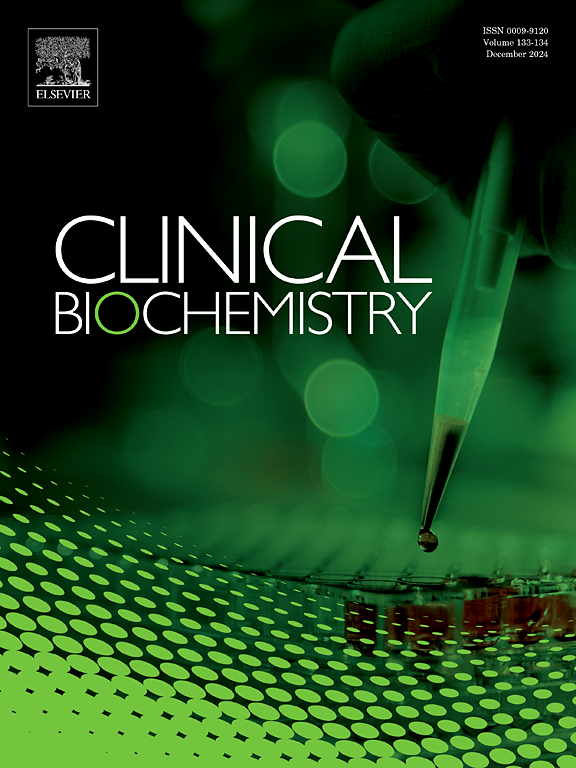在静脉造影前肾功能检查中发现意外的肌酐结果。
IF 2.1
3区 医学
Q2 MEDICAL LABORATORY TECHNOLOGY
引用次数: 0
摘要
背景:慢性疾病发病率的增加推动了静脉(IV)造影诊断成像。虽然静脉注射手术在很大程度上是安全的,但在有易感因素的患者中,造影剂诱导的神经病变风险需要在静脉注射前进行肾脏评估。虽然常见,但即时肌酸酐(POC)检测容易产生模棱两可的结果。这经常导致耗时的重新测试、重新安排预约、患者痛苦和医疗负担。病例介绍:糖尿病,高血压,慢性肾病高加索男性,61岁,提出了一个计划静脉对比增强计算机断层扫描。他最初基于poc的肌酐结果为1.20 mg/dL(106.1 μmol/L),略高于参考区间(0.67—1.17 mg/dL[59.2—103.5 μmol/L])。考虑到患者已有的疾病,我们进行了实验室肌酐测试以确保其肾功能。新结果为0.95 mg/dL(84 μmol/L),在正常参考区间内。0.25 mg/dL(22.1 μmol/L;20.8 %),同时延迟静脉注射手术,这促使临床医生要求进行深入的实验室调查。结论:采用以患者为中心的指标,如个体化指数、参考变化值和基于受试者的参考区间,进行综合分析,减轻了对其肾脏健康和检测结果差异的担忧。本文章由计算机程序翻译,如有差异,请以英文原文为准。
Navigating an unexpected creatinine result during a pre-intravenous contrast renal function workup
Background
Increasing chronic disease incidence drives intravenous (IV) contrast-based diagnostic imaging. While IV procedure is largely safe, contrast-induced neuropathy risk in patients with predisposing factors demand pre-IV renal assessment. Although common, point-of-care creatinine (POC) tests are prone to generating ambiguous results. This frequently result in time-consuming retests, rescheduled appointments, patient distress, and healthcare burdens.
Case Presentation
A diabetic, hypertensive, and chronic kidney diseased Caucasian male, aged 61, presented for a scheduled intravenous contrast-enhanced computed tomography scan. His initial POC-based creatinine result of 1.20 mg/dL (106.1 μmol/L) narrowly exceeded the reference interval (0.67–––1.17 mg/dL [59.2 – 103.5 μmol/L]). Given the patient’s pre-existing conditions, laboratory-based creatinine test was performed to reassure his renal function. The new result was found to be 0.95 mg/dL (84 μmol/L), which fell within the normal reference interval. This substantial disparity of 0.25 mg/dL (22.1 μmol/L; 20.8 %) between creatinine tests while delaying the intravenous procedure prompted the clinicians to request an in-depth laboratory investigation.
Conclusion
Comprehensive analysis using patient-centered metrics such as index of individuality, reference change value, and subject-based reference interval alleviated the concerns on his renal health and disparity in assay results (<0.3 mg/dL≡ <26.5 μmol/L) total allowable error limit), thus allowing intravenous contrast imaging.
求助全文
通过发布文献求助,成功后即可免费获取论文全文。
去求助
来源期刊

Clinical biochemistry
医学-医学实验技术
CiteScore
5.10
自引率
0.00%
发文量
151
审稿时长
25 days
期刊介绍:
Clinical Biochemistry publishes articles relating to clinical chemistry, molecular biology and genetics, therapeutic drug monitoring and toxicology, laboratory immunology and laboratory medicine in general, with the focus on analytical and clinical investigation of laboratory tests in humans used for diagnosis, prognosis, treatment and therapy, and monitoring of disease.
 求助内容:
求助内容: 应助结果提醒方式:
应助结果提醒方式:


